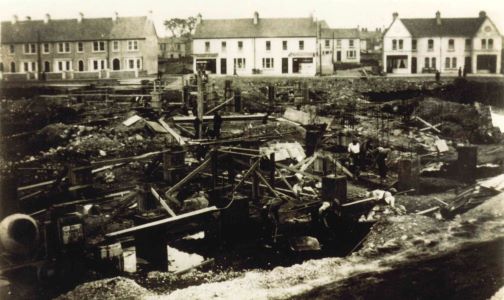Old Galway
The Seven Wonders of Galway

I was asked a question some time ago that stopped me in my tracks, “What, for you, would be the seven wonders of Galway”? It made me think long and hard and I decided to draw up a list.
HYNES’ SHOP, A BRIEF HISTORY

by Tom Kenny
In the 1920’s a family named Healy from College Road built three houses on Forster Street. The owner of the first house (next door to Harry Clare’s stone mason’s yard) was a Jewish man named Isaac. He did piano repairs and his daughter was an opera singer. He worked from a shed at the back of the house. In the 1930’s, he sold the house to John McDonagh from Glann near Oughterard who was married to Mary Anne Spellman from Fermoyle. They opened a grocery shop and a lending library.
THE GALWAY CAROL SINGERS

by Tom Kenny
The Galway Carol Singers were formed in the late 1930’s by members of the Junior Conference of the St. Vincent de Paul. It was Benny Brennan from West House who got the idea originally and then a committee was formed from various conferences in town. It included Robert Pierce, Joe Lardner, Paddy Donoghue, Mattie Fahy, John Fahy, Pádraic Spelman and Peter Griffin. The idea was for the singers to raise much needed funds for the Society.
The Galway Carol Singers

The Galway Carol Singers were formed in the late 1930’s by members of the Junior Conference of the St. Vincent de Paul.
FATHER GRIFFIN ROAD

by Tom Kenny
This view of part of Father Griffin Road was taken from Father Burke Road c.1955. In the foreground you can see the land being levelled and prepared for the building of the Technical School.
Much of the land in this area was described in 1681 as “the wett piece of ground mearing on the highway to Kilcorkey” and was known as ‘Feeney’s Marsh’. Later it was part of the Colohan Estate, the Colohans lived in a large house at the Crescent and their lands extended all the way to the sea. Father Griffin Road was constructed in the early 1930’s. Before that, the main thoroughfare was Munster Avenue which connected to Trimm’s Lane (now Whitestrand) and went from William Street West to Grattan Road. The swampy ground to the rear of the Technical School was locally known in the 1930’s as ‘Tom Mannin’s Bog’.
THE WESTERN ALL-STARS, 1963

by Tom Kenny
After the war, there was a bit of a building boom of dance halls around the country. Radio had introduced popular music to the general public and more and more people wanted to move to the music, so dance bands began to form. Some of those in Galway were Des Fretwells’ Band, Maxie Dooley’s Musicmakers, The Bill Keaveney Orchestra and Gerry Cahill’s Dance Band. They played the popular music of the day, were mostly seated on stage and reading the music from stands in front of them. Then along came Bill Haley and Rock & Roll and everything changed. The showbands had arrived. Music stands were forgotten, musicians played standing up and literally began to move with the times.
B. CONNOLLY SONS & CO., THE CONNAUGHT BUILDINGS

by Tom Kenny
The Connaught Buildings in Mainguard Street were established in 1861. The complex formed the business of Bartley Connolly and Sons. He advertised extensively as “By Special Appointment, Purveyor to H.R.H. the Duke of Edinburgh; and to his excellency The Lord Lieutenant, and Chief Executive for Ireland”. They were major wine importers, spirit merchants, family grocers and Italian warehousemen.
Independent Radio Galway

In 1978, RTE were on strike for some time which meant the repair shop in O’Connor TV had nothing to do, so John O’Sullivan and friends built a 30-watt transmitter and this prompted Tom O’Connor, John O’Sullivan and Eamonn Geary to get together and set up a pirate radio station called Independent Radio Galway.
.png)